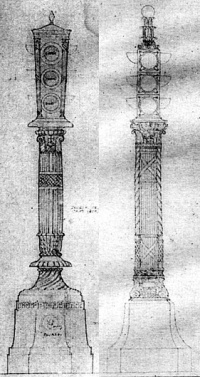New Jersey - Newark Traffic Tower
Tower History
An idea initiated in 1923, the traffic towers of Newark were brought to fruition in 1925. Unhappy with the tower designs of other cities, they too hosted their own competition for a design of a traffic tower, awarding first place to Nathan Harris. Also on Aprio 10, 1924 second prize was awarded to George W. Backoff and W. Pierre Aquin.
While called a traffic tower this design was more of an ornamental traffic signal mounted on a traffic island. Unlike designs in NYC, Detroit, and elsewhere, there was no room inside for an officer to be stationed.
Random Writing to Cleanup
The Newark Traffic Tower (sometimes referred to as the Four Corners [1] Traffic Tower') was erected at the intersection of Market & Broad Streets in Newark NJ in 1925. It remained in service for fifteen years until it was dismantled in 1939. It was designed by Nathan Harris and built to control the (at that time) World's busiest intersection. In 1915, Public Service counted over 280,000 pedestrian crossings in one thirteen-hour period. Eleven years later, on October 26, 1926, a State Motor Vehicle Department check at the Four Corners counted 2,644 trolleys, 4,098 buses, 2657 taxis, 3474 commercial vehicles, and 23,571 automobiles. - [2]
An excellent recounting of its history can be read here: VirtualNewark[3].
There seems to be some controversy over which municipality was the first to install a traffic tower with both New York City[4] and Detroit[5] laying claim to being the first (1916 & 1917 respectively). Here's a photo of the NYC tower on Fifth Ave. and 42nd St. [6]
While it's unlikely the Newark tower was the first, it did last 15 years before being replaced with a more conventional traffic signal system. Oddly enough, as Newark dismantled their traffic tower in 1939, Meriden, CT just got around to electrifying theirs a year later[7].
GoogleMapView[8]
Fortunately, in 1939 when the city of Newark decided to replace the tower, Samuel Kessler (a Newark attorney) was able to convince the city to allow him to move the tower to a property of his by paying for all the related expenses ($2000 in 1939 which translates to almost $28,000 in 2006 dollars[9]). Mr. Kessler's property was actually a park (Crest Haven Memorial Park in Clifton) which later became Crest Haven cemetery. The tower remains preserved there today (on shorter legs).
References
- American City Municipal Index and Atlas, May 1924, pg. 545, "Competitive Designs for Traffic Towers," Ogden H. Bowers - Exec. Mgr. Broad Street Association.
- [Need to Add References from the Cleanup Section Above]

